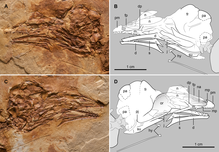| Junornis Temporal range: Early Cretaceous,
| |
|---|---|

| |
| Slab and counterslab of the holotype specimen | |
| Scientific classification | |
| Domain: | Eukaryota |
| Kingdom: | Animalia |
| Phylum: | Chordata |
| Clade: | Dinosauria |
| Clade: | Saurischia |
| Clade: | Theropoda |
| Clade: | Avialae |
| Clade: | †Enantiornithes |
| Genus: | †Junornis Liu et al., 2017 |
| Type species | |
| †Junornis houi Liu et al., 2017
| |
Junornis is a bird genus, belonging to the Enantiornithes, that during the Early Cretaceous lived in the area of present China.
Discovery

At Liutiaogou village, near the town of Daming in Ningcheng County, Inner-Mongolia, a bird skeleton was excavated that was acquired by the Beijing Museum of Natural History. It was further prepared by Maureen Walsh.[1]
In 2017 Liu Di, Luis M. Chiappe, Francisco Serrano, Michael Habib, Zhang Yuguang and Meng Qinjing named and described the type species Junornis houi. The generic name is derived from Chinese jun, 俊, "beautiful", and Greek ornis, "bird". The specific name honours the Chinese paleoorntithologist Hou Lianhai.[1]
The holotype, BMNHC-PH 919, was found in a layer of the Yixian Formation that is roughly 126 million years old. It consists of a skeleton with skull, compressed on a plate and counterplate. The skeleton is largely associated, though the skull is detached. Bone conservation is excellent. Extensive remains of the plumage have been preserved.[1]
References
- ^ a b c Liu, D.; Chiappe, L.M.; Serrano, F.; Habib, M.; Zhang, Y.; Meng, Q. (2017). "Flight aerodynamics in enantiornithines: Information from a new Chinese Early Cretaceous bird". PLOS ONE. 12 (10): e0184637. Bibcode:2017PLoSO..1284637L. doi:10.1371/journal.pone.0184637. PMC 5636078. PMID 29020077.


